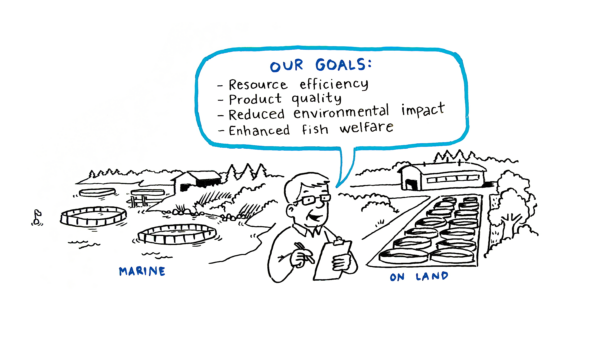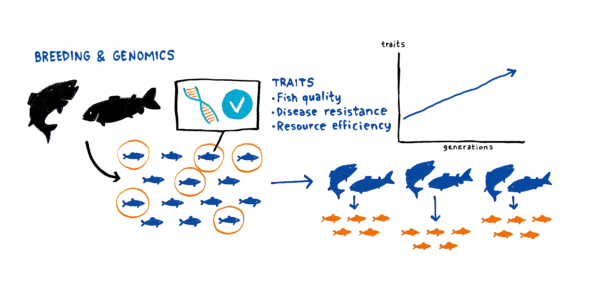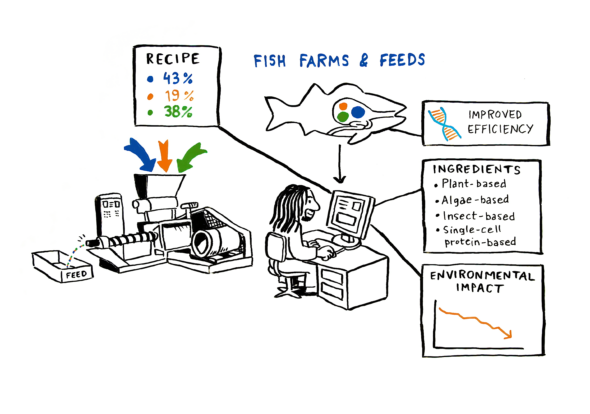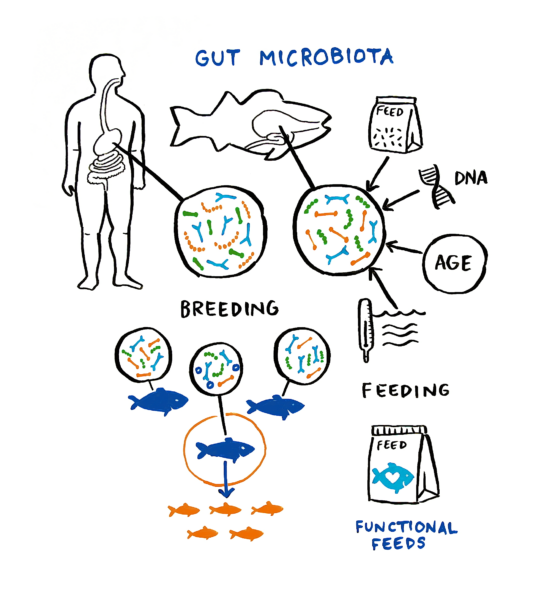After 5 years of intensive work, AquaIMPACT has come to its end, and it is a good time to look back and summarize our main achievements. But first, I want to thank the marvelous group of hard-working experts that participated this unique and ambitious project.
Both breeding and nutrition technologies have been fundamental for developing aquaculture, but mostly as separate technologies without much cross over between them to reach a common goal. AquaIMPACT was a major effort to integrate the fields of fish breeding and nutrition to increase the competitiveness of EU’s aquaculture of Atlantic salmon, rainbow trout, gilthead sea bream and European sea bass, to ensure food and nutrition security and to satisfy consumer demands for high-quality seafood with limited environmental impact.
AquaIMPACT has:
- Demonstrated the success of commercial selective breeding programmes in improving fish traits (profitability, reduced environmental impact)
- Facilitated the implementation of genomic selection in breeding programmes, to take breeding programmes to the next level
- Developed feed formulas, feed additives and nutritional strategies for the fish originating from breeding programmes
- Demonstrated that gut microbiota has a role in responses to dietary treatments, feed development and breeding
- Developed smart software, computing and automated phenotyping to improve cost-efficiency of breeding and feed development
- Assessed consumer perception and ways to communicate about these developed methods and aquaculture production methods in more general.
AquaIMPACT finalised 13 Business plans and 7 Exploitation plans for the developed products, protocols, services, software, and results. Active dissemination has been practiced via 71 news articles in our Newsletter, 40 scientific publications, social media platforms (X: @aqua_impact) and via webinars and presentations. The AquaIMPACT outputs are good examples of science-based innovations.
Our name, AquaIMPACT, arose from the urge that the consortium focuses on making a change, a moderate but significant change, that takes aquaculture breeding and feed development forward. At a personal level, the project has allowed people to develop their skills, learn from each other, and progress in their career.

8 EXPECTED IMPACTS
One way to summarize our success is to compare our output to the eight expected impacts stated in the original call text. These expected impacts have been derived from the EU’s strategies to develop more sustainable food sector in the EU.
1 – Investment in sustainable aquaculture research and innovation leads to the creation of new value chains, markets, growth and jobs
AquaIMPACT developed methods to make farming of the four main fish species more competitive. Our partners have already started or are going to implement many of the innovations. AquaIMPACT provided demonstrations and calculations of the benefits and cost-efficiency of novel products, services and practices. AquaIMPACT tested ways to use alternative feed ingredients such as insects and single-cell proteins whose production is a new part of a supply chain. AquaIMPACT also produced innovations and practices for services and technology that are not so commonly the focus in EU projects. It should be noted that several of the AquaIMPACT partners make products and services in the EU that are marketed outside of the EU. These companies are not dependent on the aquaculture only in the EU, but effectively exploit the expanding aquaculture sector e.g., in Asia and Americas. A major part of the budget was allocated to the company partners to ensure that the focus is on the implementation of the results.
2 – Improve consumers’ awareness, perceptions and acceptability of aquaculture
AquaIMPACT has been active via all its communication channels in distributing knowledge on the new aquaculture practices, and specific tasks addressed the way consumers react to the information and in which format consumers would want the information. This aids in distributing information to citizens. News and videos for common public were produced and distributed. For our promotional video, see https://www.youtube.com/watch?v=gsuyVkzdfd4.

3 – Contribute to the creation of improved sustainable aquaculture systems and implement productive and resilient aquaculture practices that maintain healthy aquatic ecosystems and strengthen capacity for adaptation to climate change
AquaIMPACT methods were chosen so that they represent sustainable ways to improve aquaculture. The goal of the developed breeding, genomic and nutritional methods is to improve fish health, disease resistance, resources use, product quality and performance across production environments, and to assess the use of feed ingredients that reduce the pressure on the aquatic ecosystems. Breeding adapts fish to climate change.
4 – Improve food security and improve nutrition, and promote sustainable aquaculture
Current global situation in which the global supply chains do not function properly emphasise the need for secure food production that is practiced in the EU. A major part of sea food consumed in the EU is imported. AquaIMPACT, with its novel methods, is one effort to make EU companies stronger and more visible, and to increase EU’s self-sufficiency in aquaculture.

5 – Contribute to the utilisation of genetic resources
Selective breeding programmes of the four major European farmed fish species developed in AquaIMPACT contribute to the sustainable use of genetic resources. The developed selection methods can be used for other species.
6 – Contribute to increasing available, accessible, affordable and nutritious food and feed, while conserving natural resources and contributing to climate change mitigation
AquaIMPACT tasks to develop aquaculture itself and to formulate feeds with lower amounts of fish oil and fish meal reduce the negative impacts of fisheries on wild fish and aquatic communities. AquaIMPACT partners are world leading feed developers and producers. Improved resource efficiency via breeding reduces CO2 impact per produced kg of fish.

7 – Improve the professional skills and competences of those working and being trained
Active co-doing between researchers and companies across fish nutrition, breeding and genomics, microbiota research and digitalisation, and active dissemination both internally and externally ensured improvement of competences of all AquaIMPACT partners and other interested people. Three training courses have been organized, and three PhD thesis were completed. A minimum of 147 people worked in AquaIMPACT.
8 – Contribute to policymaking in research, innovation and technology
AquaIMPACT generated two policy briefs relevant for the industry, accompanied other projects’ policy making efforts, and a Breakfast Policy Briefing event was organised in the EU parliament. In short, the messages are that a) the AquaIMPACT concept of combining breeding and feed development is applicable to solve many new challenges such as improvement of RAS, and b) the revolution within the sequencing and genotyping industry has unveiled unprecedented opportunities to usher in a new era of advanced genome-based breeding capable of addressing the challenges of aquaculture. The combination of computational genetics, bioinformatics and genotyping is needed to develop next generation utilization of genomics data across aquaculture species for both simple low-cost breeding as well as for high-tech breeding companies.
Antti Kause (Natural Resources Institute Finland, Luke), the AquaIMPACT coordinator
